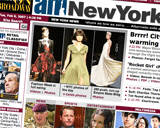 Christopher Barnes first had the idea for setting up a free morning newspaper in New York after witnessing the success of the London Metro.
Christopher Barnes first had the idea for setting up a free morning newspaper in New York after witnessing the success of the London Metro."Forty per cent of the nation's mass-transit is in New York, it has the longest commute times and affluent people taking the subway," said Mr Barnes.
“It really is a very comparable market to London in many respects and we felt it was just going to be a home run. Turns out we were right."
After being part of the team that introduced the international version of the Metro to Boston, he launched AM New York in October 2003, and became publisher of the city's first freesheet.
"We could give out as many papers as we can print right now, the problem we have is running out of copies sometimes. It has been a success since the day it launched."
The success, Mr Barnes says, led to a daily print run of 325, 000 copies distributed through 1,000 news boxes and165 promoters at major subway stops. Little wonder that Metro launched in New York six months after AM New York first hit the streets.
Yet Mr Barnes said his policy was to expand his publication's offering beyond the commuter run and make the paper and its website a seamless brand of interaction. Launched just a year ago, the online offering now boasts 500, 000 unique users a month.
Despite being a morning paper, it often breaks stories online and reverse publishes content from website into the next day's print edition.
The model for the freesheet, Mr Barnes added, is similar to (and fits well with) an online publication as they both rely heavily on advertising and give content away for free.
The publication's sales team is twice as big as its editorial staff (30 compared with 15) and it draws editorial on national news from the Tribune group (which owns it) Washington Post and LA Times while writing the majority of the local news in-house.
It is also in the process of adopting a joined-up approach to classified advertising where adverts on the website are sold to provide a greater depth of information to a sister short advert in the paper. He added that, unlike other newspapers, AM New York had not felt the squeeze of revenue from classifieds as it was a young paper still in its growth phase and has managed accordingly.
"When I'm out explaining AM New York to advertisers, I like to compare it to a website and say people aren't necessarily paying for this, in the same way they are not paying for a website, but they are making the effort to pick it up and engage with the content.
"It's really similar to a web experience because of the audience. We have young urban professionals of the interactive generation, cash rich, time poor, who are not really engaged with traditional media - they are our readers.
"We give them a 20 to 30 minute read on the subway so that they are not going to have to flick through a six-section newspaper."
The majority of American weekday newspapers, Mr Barnes believes, will eventually adopt the shorter, snappier approach to meet the demands of an increasingly time-short readership - adding that the arrival of his freesheet brought a new audience to newspapers that otherwise would have gone to the internet for their news.
"It evolved like this because effectively we are feeding the same market [as news websites]. We wanted to give people news that they would not have to ponder on - just get to the point, lay it out in a simple, easy-to-navigate way, not throw in a lot of opinion so make it politically neutral... it's to the point and brief."
He added: "Papers are still very successful here, Newsday has close to a daily 500, 000 circulation, the Post and the News at around 700, 000. They are still very viable, engaging products. We’re just reaching an audience that is not engaging with them."
Free daily newsletter
If you like our news and feature articles, you can sign up to receive our free daily (Mon-Fri) email newsletter (mobile friendly).
Related articles
- Washington Post releases year-in-review feature for subscribers
- From Reuters to The New York Times, Big Oil pays 'most trusted media brands' to push greenwashing
- The Washington Post discovers an engaged gaming audience
- Four digital media trends to watch: generative AI, Gen Z, business models and news formats
- Subscription retention strategies: pain points and remedies









